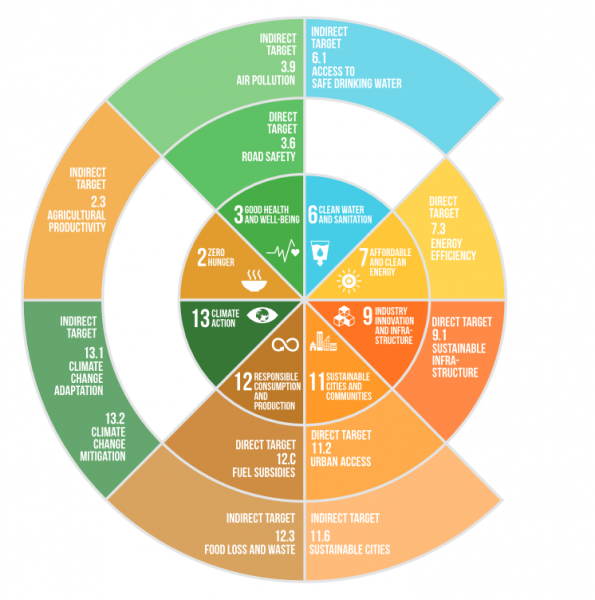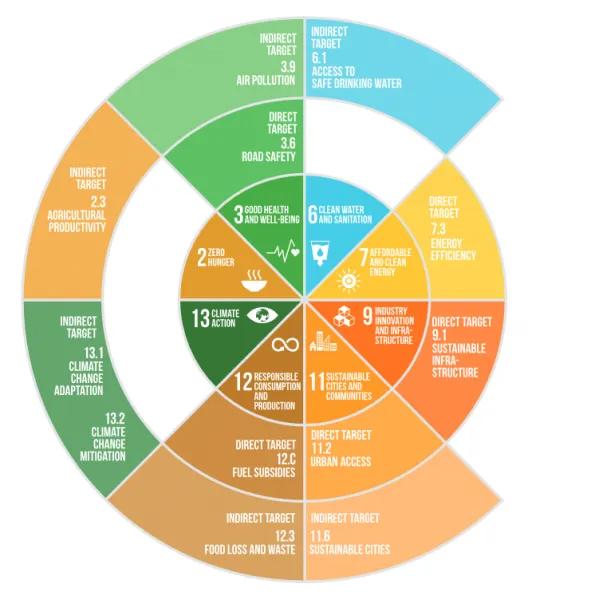By Cara Kennedy-Cuomo
Reforming urban transport can be a strong catalyst for achieving the Sustainable Development Goals (SDGs). Arguably, the transportation sector can be linked to each and every one of the Goals, especially those related to food security, health, energy and climate change, infrastructure, cities and human settlements. It is directly mentioned in eight SDGs, depicted below.

Image: Partnership on Sustainable Low Carbon Transport
It is most explicitly mentioned in Goal 11 target 2, which reads: “By 2030, provide access to safe, affordable, accessible and sustainable transport systems for all, improving road safety, notably by expanding public transport, with special attention to the needs of those in vulnerable situations, women, children, persons with disabilities and older persons.”
In many cities, public transport remains unsustainable, unsafe, inefficient, inaccessible or unaffordable – a situation that is particularly affecting the poor, promotes marginalization, and can deepen social inequities. Nearly 1 billion people worldwide still lack adequate access to road networks. Economically, sustainable urban transport should connect people to markets, jobs, goods, and other people. Specifically in Malaysia, an emphasis on trans-border infrastructure, like much of that proposed by the One Belt One Road, can support economic development.
Socially, innovation in public transportation can improve population health by decreasing road deaths and accidents. In 2016 in Malaysia, 7,152 people were killed in 521,466 road accidents. That is nearly 20 deaths every day, at a cost to the country of over RM 9 billion. Malaysia has been ranked as having the third highest deadliest roads in the world by the World Health Organization. Also in terms of safety, we should work towards designing public transport systems that reduce the vulnerability of women and girls to sexual violence and abuse while travelling, reduce the incidence of mugging and robbery that occur either on public vehicles or in public transport stations, and create better processes for drivers and passengers to recognize and report instances of human trafficking.
Pollution is both a public health issue and an environmental issue. Public transportation systems should be “green,” in that they are energy efficient and rely on environmentally-friendly energy sources that do not pollute as much as fossil fuels. The transport sector is responsible for one quarter of energy-related greenhouse gas (GHG) emissions worldwide, with its emissions increasing at a faster rate than any other sectors. Public transport can also be made more resilient to natural disasters and changing weather patterns. Many Malaysians are familiar with how flash flooding can cause traffic to come to a standstill. This, and other environmental issues, should be addressed.
Sustainable transport must be integrated as an essential ingredient in sustainable development strategies. Transport infrastructure lasts for decades, which means that the decisions that the local and national governments make today will have long-lasting impacts on urban development and form, as well as climate.
Urban Transport
A transportation system is the mix of buses, trains, cars, bicycles, and foot paths people use to get around. The fundamental usefulness of a transportation system, can be predicted by measuring its mobility and accessibility, the “ying and yang” forces of speed versus granular access. For instance, a major highway is very mobile: vehicles can travel at fast speeds, and the road can support a lot of cargo. However, it is not immediately reachable by most households and offices. For accessibility a city needs smaller roads, all the way down to lanes and alleys, that are slower but increase the reach of the transportation system.
On Monday, November 6, 2017, Datuk Ir Dr. Leong Siew Mun visited the offices of The Jeffrey Sachs Center. Engaging, bright, and smiling, he led a discussion on Sustainable Urban Transportation, specifically how both Sunway City and Malaysia’s transportation systems could be reimagined to be greener, be more socially inclusive, and better foster economic growth.
As the former executive director of Dewan Bandaraya Kuala Lumpur (DBKL), Ir Dr. Leong has put a lot of thought into determining the best trade offs between accessibility and mobility. At DBKL, he led the design and implementation of Intelligent Transport Information System (ITIS) applications for urban traffic management. ITIS systems, he said, could transform the way we design transportation.
Simply put, ITIS is a complex network of data collection, so that people and algorithms can quickly evaluate traffic patterns and take action to alleviate traffic congestion and improve road safety. That action can either by immediate, like responding in real time to traffic accidents; or longer term, like using data to better design and manage traffic flow. In Ir Dr. Leong’s determination, new capital-intensive buses and carparks will actually be less cost efficient than investing in ITIS technology and traffic management systems to solve Malaysia’s public transport needs.
Sustainable Urban Transport
Transportation allows for the quantitative increase and geographic spread of sustainable development. Transportation facilitates economic growth through the transfer of goods and people, both in mass volume and across regions; affects environmental quality, due mainly to the noise and air pollution caused by traffic; and affects social well being, by the safety, affordability, and physical accessibility of transport systems.
Sustainable urban transport, therefore, has a lot of components. It should be both mobile and accessible, facilitate the economic, political, and social goals of the community the transportation is in, and create minimal negative impact, like air pollution and congestion. The best transportation system planning also accounts for changing urban landscapes, and ultimately the evolving needs of everyday people who use the transportation system.
Sustainable Urban Transport in Malaysia
All of these insights into how to best design a sustainable urban transport system can be tailored towards the local circumstances in Malaysia. Ir Dr. Leong made a point to address the changing ways people like to get to where they’re going, and how this will affect our communities.
For instance, before creating legislation to disincentivize selling or buying cars, Malaysians may want to take into account ramifications of taking cars off the road, because of the economic importance of automotive sector. The increase of ridesharing services, like Uber and Grab, also factor into this decision, as it is unclear if they increase or reduce the amount of car traffic. Conversely, bike sharing apps that are gaining popularity in Malaysia, like oBike, more clearly promote sustainability. However, further policies that incentivize walking and biking might not be as practical, as the weather in Malaysia is not conducive to travelling outside. People often try to avoid arriving at their destination wet – either from rain or sweat.
Sunway’s own public transportation system has been awarded for its innovation in sustainability. The BRT is an all-electric bus service and transports up to 1,000 passengers per hour. This sustainable solution can be expanded to meet even more of the Sunway community once costs are restructured, as currently for many commuters it is more expensive to use public transport than it is to drive. Malaysia is already developing future innovations described by Ir Dr. Leong, like self-driving buses and traffic systems that use sensors to adapt in real-time the red-yellow-green traffic light cycle, based on traffic flow.
Where we are now and where we can be
It is no wonder that roads are congested. As of 2014, Malaysia had the third highest rate of car ownership in the world, with 93 percent of households owning a car. Residents of Greater Kuala Lumpur spend more than 250 million hours a year stuck in traffic, or around 20 days a year per person. The government aims to increase public transport’s share of journeys to 40% by 2030. As of 2014, 17% of commuters in Kuala Lumpur used public transport, compared with 62% in Singapore and 89% in Hong Kong. However small 17% may seem now, that number is quickly growing.
Congestion threatens to dampen the benefits of urbanization. Malaysia’s rapid urbanization boosted productivity and access to economic opportunity, helping raise incomes and reduce poverty. But urban sprawl, high motorization rates and inadequate public transport are leading to congestion and low usage of public transport; not to mention making the prospect of reducing CO2 emission from motorized vehicles seem like not much more than a pipe dream.
The lack of unified planning is a key obstacle to the delivery of efficient urban transport. By using ITIS, and more broadly focusing on what sustainable urban transport means to Malaysians, we can move closer to a wealthier, cleaner, and happier city and country.
1 https://www.thestar.com.my/news/nation/2017/02/02/road-accidents-cost-malaysia-rm9dot2bil-in-2016/
2 http://says.com/my/news/malaysia-s-roads-among-the-world-s-most-dangerous-and-deadliest
3 https://www.ashden.org/sustainable-energy/sustainable-transport
4 http://www.worldbank.org/en/country/malaysia/publication/malaysia-economic-monitor-june-2015




